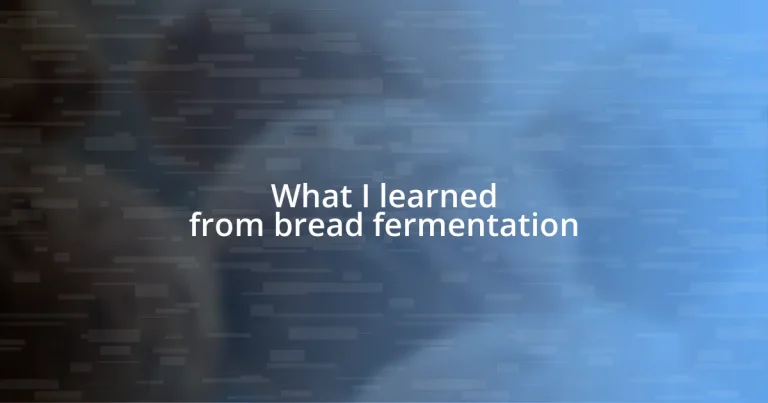Key takeaways:
- The fermentation process in bread-making, driven by yeast and bacteria, significantly influences flavor, texture, and aroma.
- Temperature, sugar content, and moisture level are critical factors that affect the fermentation process and the final bread quality.
- Observing and understanding fermentation stages, along with troubleshooting common issues, is essential for successful bread baking.

Understanding bread fermentation
Bread fermentation is a fascinating process that involves the magic of microorganisms, primarily yeast and bacteria. When I first started baking, I remember being mesmerized by the way my dough transformed; watching it bubble and rise felt like seeing life unfold in real-time. Have you ever noticed those tiny bubbles forming in your dough? That’s yeast at work, breaking down sugars and producing carbon dioxide, which gives bread its fluffy texture.
The balance of time and temperature during fermentation can dramatically affect the flavor and texture of the final loaf. I often experiment with different fermentation times, and I’ve learned that a longer fermentation can lead to a richer flavor. Isn’t it interesting how something so simple as letting dough sit can profoundly change everything? The complexity of flavors that develop during this process is one of the things that keeps me returning to the kitchen.
Furthermore, fermentation is not just about rising dough; it’s also a dance of flavors and aromas. Each time I bake, I’m reminded that the best bread often comes from a little patience. The earthy, tangy notes that develop have brought joy to my kitchen on many occasions. Have you ever tried a sourdough loaf that was fermented overnight? The depth in flavor can be astonishing, and it’s a testament to the beauty of letting nature take its course.

Importance of yeast in fermentation
Yeast plays a pivotal role in the fermentation process, acting as the primary agent responsible for converting sugars into alcohol and carbon dioxide. I remember the day I realized just how much I relied on yeast when my batch of dough failed to rise. The disappointment was palpable, and it made me appreciate yeast more than ever. Without it, the bread wouldn’t have the characteristic texture or flavor we all adore.
The choice of yeast can significantly impact the fermentation process. For instance, I’ve experimented with both active dry yeast and instant yeast, and I often find that instant yeast has a more rapid action, which can be exciting when I’m short on time. Yet, there’s something special about using active dry yeast – it not only adds depth to the flavor but also instills a sense of connection to traditional baking methods. Isn’t it fascinating how two types of yeast can create such different experiences in the same dough?
Additionally, yeast contributes not just to the rise but also to the development of aromatic compounds that enhance the overall baking experience. I recall the delightful perfume that filled my kitchen the first time I made a slow-fermented bread. That complex aroma was proof of the yeast’s hard work, and it always gets me eager to share my baked goods with friends. When we talk about bread, it’s not just about the ingredients—it’s about the story they tell and the essence of the fermentation journey.
| Yeast Type | Characteristics |
|---|---|
| Active Dry Yeast | Requires rehydration, slower fermentation, richer flavor |
| Instant Yeast | Doesn’t require rehydration, faster fermentation |

Role of bacteria in bread
Bacteria play an essential supporting role in bread fermentation, working alongside yeast to shape the final product. While yeast is often in the spotlight, I’ve come to realize that bacteria are the unsung heroes of flavor development. My first encounter with a sourdough starter was eye-opening; I could hardly believe that a mere mix of flour and water could cultivate such vibrant flavors. The tanginess I’ve grown to love in my breads is a direct result of these tiny microbes breaking down carbohydrates and producing organic acids.
Here are some fascinating aspects of bacteria in bread:
- Flavor Enhancement: Lactic acid bacteria contribute to the unique tanginess of sourdough, enriching the taste and making each loaf a delightful experience.
- Texture Improvement: They can influence the dough structure, leading to a lighter, airier crumb, which I’ve noticed in my well-fermented artisan loaves.
- Preservation: The acids produced during fermentation help preserve bread, extending its shelf life and allowing me to enjoy my creations just a bit longer.
- Nutrient Availability: Bacteria assist in breaking down nutrients, making them more accessible. I remember feeling a sense of accomplishment when I learned that fermentation could increase the nutritional profile of my bread.
- Microbial Balance: The symbiosis of yeast and bacteria creates a dynamic environment, where the interplay of flavors can change dramatically based on fermentation time and temperature.

Factors affecting fermentation process
Temperature is a crucial factor in the fermentation process, and I’ve seen its effects firsthand during my baking adventures. When I left a batch of dough to rise in a warm spot on a sunny day, it almost doubled in size within an hour! However, when I attempted the same with cooler temperatures in winter, the dough seemed stubborn, as if it was in no rush to wake up. It’s intriguing how a simple shift in temperature can transform the outcome of your bread.
Another key player in fermentation is the amount of sugar present in the dough. I’ve experimented with varying sugar levels, and I noticed that a higher sugar content can lead to a more vigorous fermentation. I remember the sweetness bursting forth in my brioche when I increased the sugar. However, too much sugar can overwork the yeast, leading to a sluggish rise and potentially leaving me with dense bread. So, how do you strike the right balance? It takes a bit of practice and a lot of tasting along the way!
Moisture content isn’t just a mere detail – it’s a defining element that affects fermentation as well. I recall a particular batch where I went a bit heavy-handed with the water. The dough became incredibly sticky, but to my surprise, it yielded a wonderfully airy bread with an open crumb structure. I often wonder if moisture is the secret ingredient that bridges the gap between a good loaf and a great one. In finding that sweet spot, I’ve come to understand that the journey of fermentation is as much about observation and experimentation as it is about following recipes.

Observing fermentation stages
The fermentation process is both a science and an art, and observing the different stages can be a little like watching a show unfold. I remember my first batch of dough bubbling away on the counter; it felt like magic when I glimpsed the tiny bubbles forming after just an hour. It made me wonder—how can such small organisms create something so transformative?
As I delved deeper into the stages of fermentation, I learned that the dough goes through distinct phases, each revealing its own performance indicators. I’ve often noticed that the initial mix is smooth and unassuming, yet as time passes, the dough starts to animate—rising and expanding with a lively energy. That transformation is truly inspiring, and I can’t help but draw parallels to personal growth; just like the dough, we all need time and the right conditions to flourish.
The aroma is another fascinating part of this observation. I still recall the moment when my kitchen filled with that distinctive sour smell; it was heartwarming, a sign that bacteria were doing their job. The delightful scent served as a reminder that, in bread-making, patience is essential. It’s easy to get anxious and rush the process, but I’ve learned that the best flavors often come from being present and attentive during fermentation. What stage has excited your senses?

Troubleshooting common fermentation issues
One common fermentation issue I’ve encountered is a dough that simply won’t rise. It’s frustrating, right? I remember preparing a loaf on an overcast day, only to be met with disappointment as my dough sat looking deflated on the counter. This taught me the importance of active yeast; I now always ensure it’s fresh by giving it a little proof in warm water with sugar. If it bubbles within a few minutes, I’m in the clear!
Another issue could be over-fermentation, where the dough rises too much and then collapses. The first time this happened to me, I felt deflated. I had left my dough unattended for too long, and it showed when it collapsed flat as I tried to shape it. Since then, I’ve learned to pay close attention to the dough. Setting a timer helps me stay vigilant, so I can catch that perfect moment when the dough has risen but hasn’t overdone it.
Sometimes, you might find your dough developing an unpleasant smell. I’ve faced this with a sour, off-putting odor filling my kitchen. It made me question my techniques! After doing some research, I discovered this can happen if the fermentation is too hot or if wild yeast and bacteria take control. I’ve since become more mindful of maintaining a controlled environment and using clean utensils to prevent such issues. What about you? Have you encountered scents that made you rethink your fermentation methods?

Practical tips for successful fermentation
To ensure successful fermentation, I highly recommend keeping an eye on your environment. I remember a particularly warm summer day when my dough seemed to take off like a rocket. It was exciting at first, but then I noticed it almost doubled in size too quickly, leading to an unexpected flat loaf. By controlling the temperature—using a cooler spot in my kitchen or even a slightly set oven—I can influence the fermentation pace, giving the yeast enough time to work its magic without going overboard. Isn’t it fascinating how just a little tweak in the environment can make such a big difference?
Additionally, hydration is key. I once made the mistake of skimping on water, thinking a stiffer dough would be simpler. The result? A dense, heavy bread that felt more like a brick than a loaf. Through that experience, I learned to experiment with hydration levels. Each time I boost the water slightly, it transforms the dough into a softer, more pliable mixture that behaves beautifully during fermentation. Have you thought about how the right balance of moisture can change your results?
Lastly, trust your instincts and embrace your observations. I often find myself standing in front of my dough, admiring its bubbly surface, and sometimes, that’s all I need to gauge its readiness. Relying solely on timers can lead to missed cues, like that moment when the dough stops sticky and becomes glistening and elastic. Listening to the dough is an art. It’s a conversation—one that speaks through texture, aroma, and fermentation bubbles. Have you ever paused to truly connect with the dough you’re working with?














